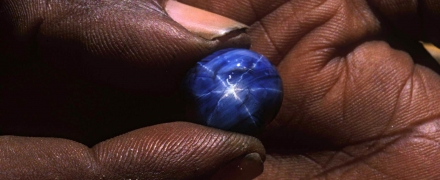open 10 am - 7 pm
laboratory is closed
Stars in gemstones

In this post we will talk about "asterixes" - stones with the optical phenomenon of asterism. The name of the effect is derived from the ancient Greek "άστήρ" - "star". The optical effect of iridescence, which determines the presence of a 3, 4, 6 or 12-rayed star in a stone on its surface or "hovering" above the stone, is associated with the reflection of light by internal irregularities in the stone and is most clearly manifested when illuminated by a point directional light source and weakens, until it disappears completely, when illuminated by diffused light. The reason for this phenomenon is the mineral, liquid, gas and gas-liquid inclusions in the stone oriented along the crystallographic directions in the stone. The most famous stones in which asterism is manifested are the varieties of corundum - ruby and sapphire. This effect is also manifested in spinel, in garnets of the almandine-pyrope mineral series, in pink quartz, in beryl (usually from deposits in Brazil), in minerals of the pyroxene group, most often in diopside and enstatite. Sometimes asterixes are referred to as “asterix-hairs” - colorless (rock crystal) or smoky quartz with rutile inclusions growing together in the form of a six-rayed star. Stones with the phenomenon of asterism can be a product of laboratory and industrial synthesis. This applies to synthetic corundums, the most famous of which are synthetic star stones from Linde. Also widespread are natural corundums with refining, creating the effect of iridescence in the form of a six-pointed star.
В геммологической практике бывают весьма увлекательные случаи с диагностикой ювелирных вставок
Но помимо редкости цвета и высокой стоимости таких камней, многие розовые камни выделяются одной замечательной особенностью – они проявляют плеохроизм, то есть в зависимости от положения осмотра камня он может иметь дополнительные оттенки – оранжевый или пурпурный.
Currently, gemstones are produced by two fundamentally different technological methods - the High Pressure - High Temperature method (“HPHT”, High-pressure & High-temperature) and the Chemical Vapor Deposition (“CVD”, Chemical vapor deposition) method. The "HPHT" method is the most tested classical synthesis method, which can be used both carbon deposition on diamond from flux melts and catalytic reactions. In "CVD" synthesis, diamond growth occurs on a seed during carbon deposition mainly from a gaseous medium at relatively low temperatures and pressures.
Jewelry and precious stones are just such a category of goods, when buying which you need to pay attention to many criteria.
Sogdianite is a rather rare mineral and more often it can be found as a collection material (moreover, in systematic collections), and it is extremely rare in jewelry.






